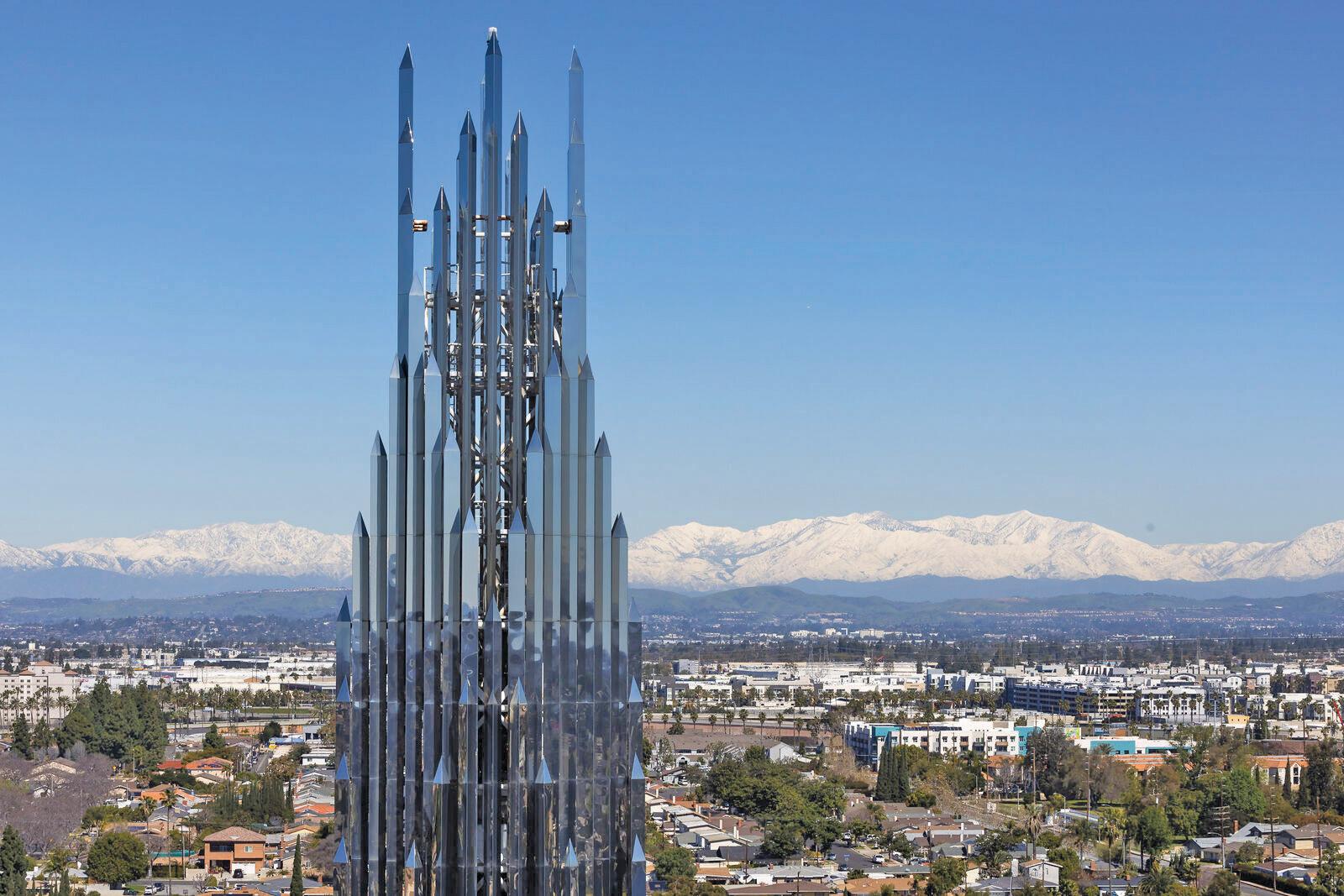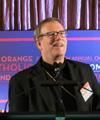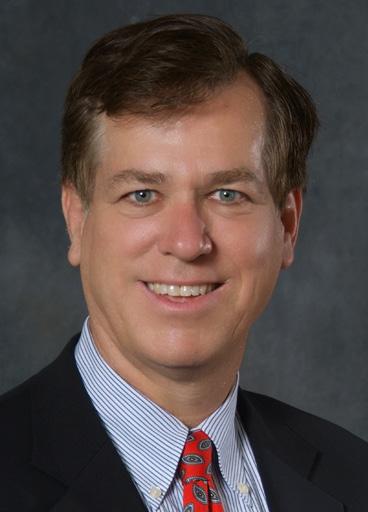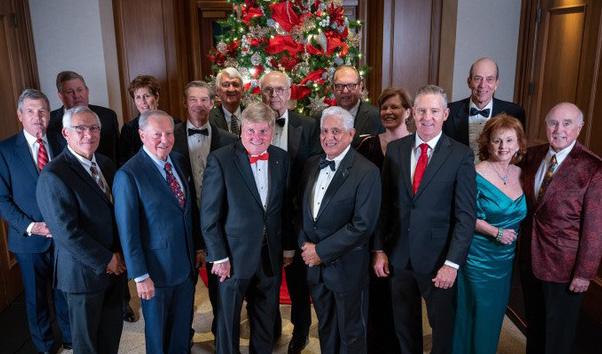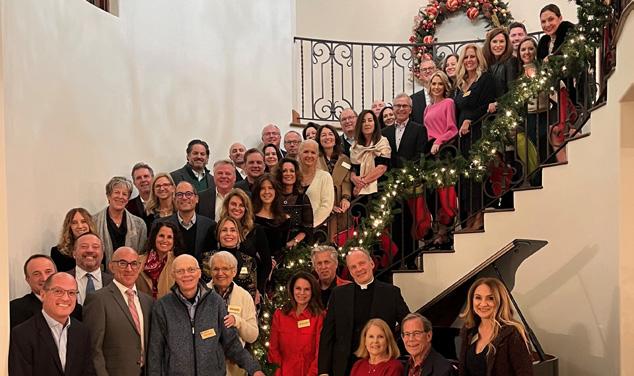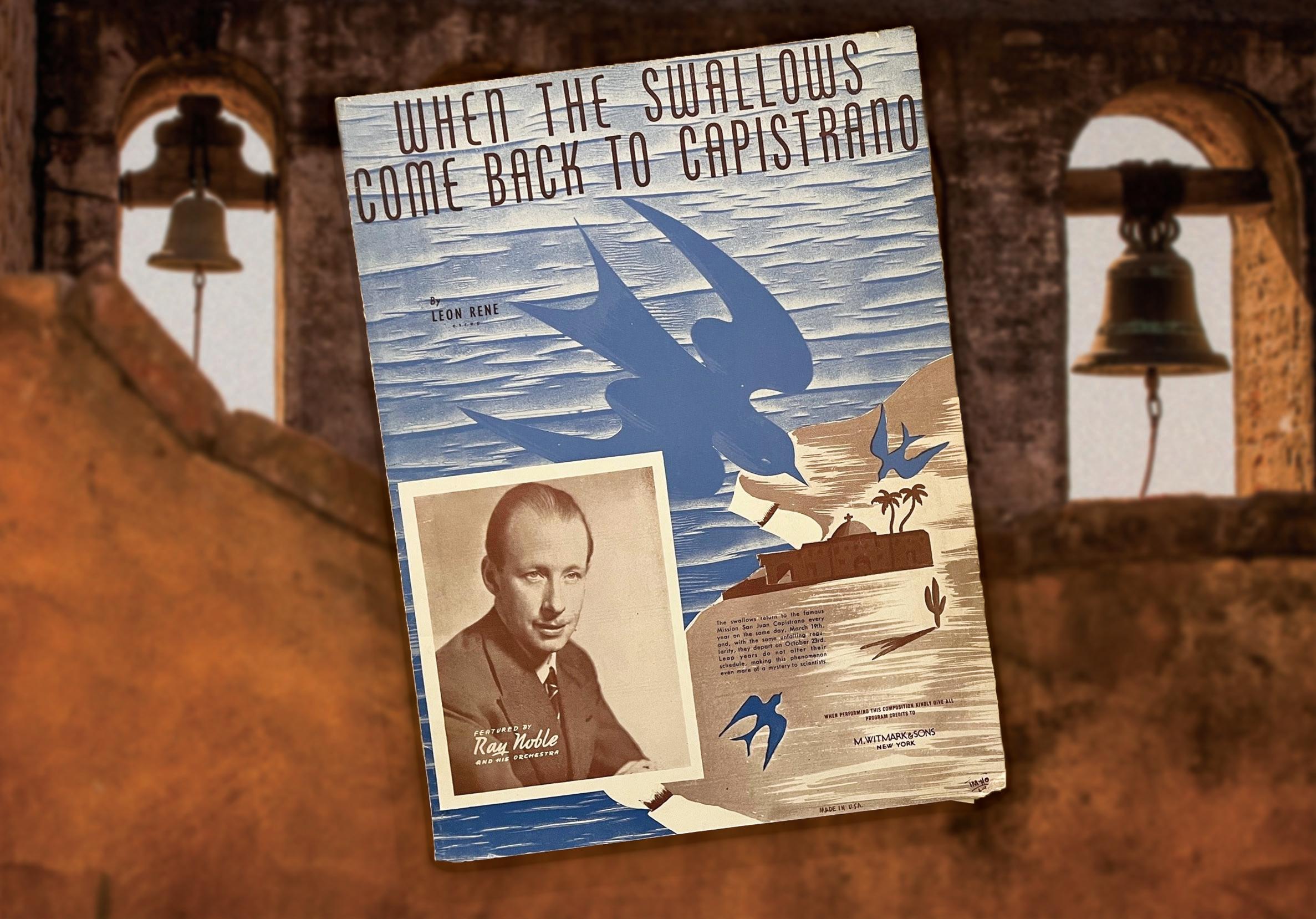

“WHEN THE SWALLOWS COME BACK TO CAPISTRANO”
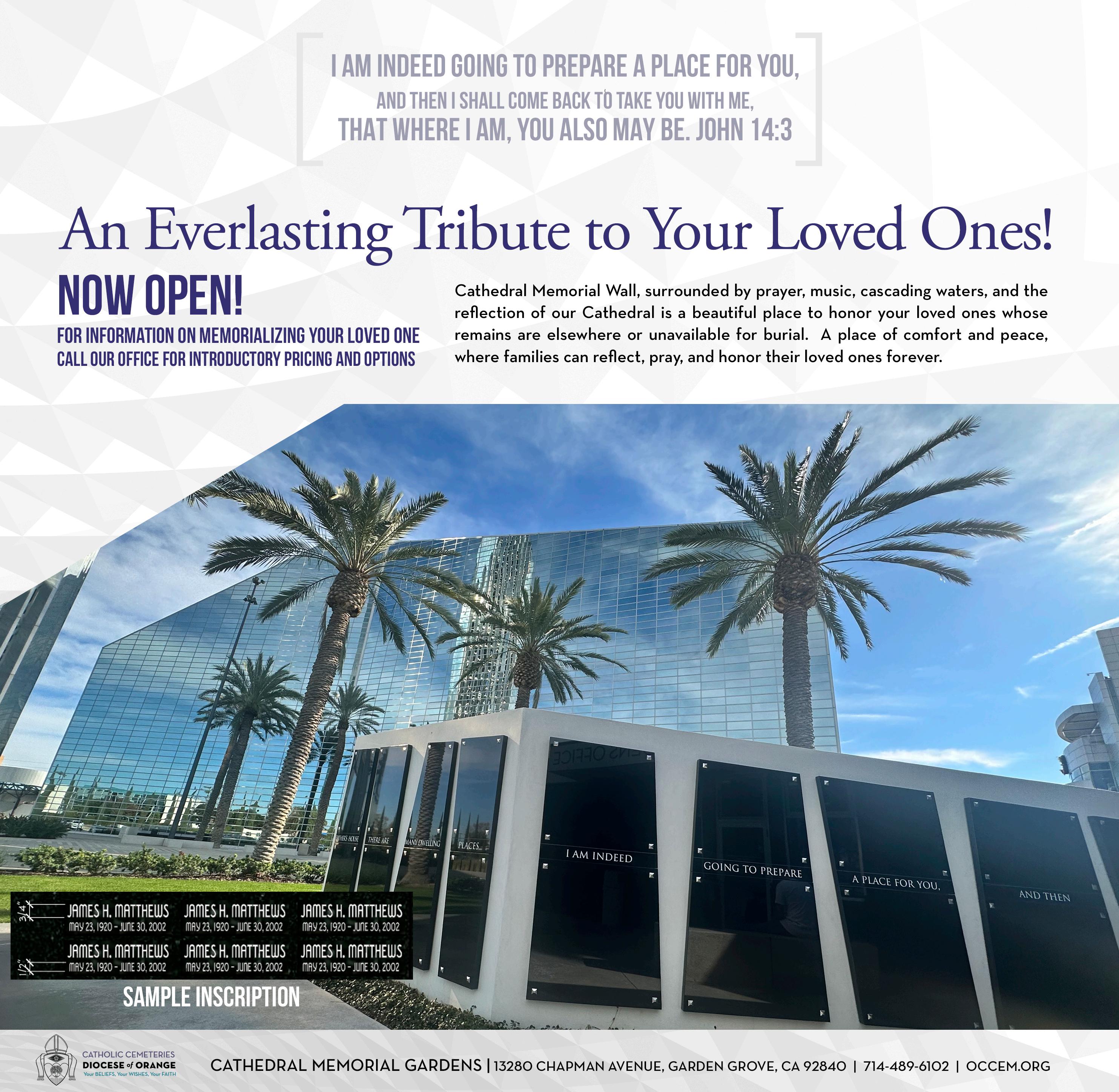



“WHEN THE SWALLOWS COME BACK TO CAPISTRANO”

The little ways we can choose to help others add up to grace over the years.
The Mission San Juan Capistrano is the most famous of the California Mission chain, for good reason.
Our Lady Queen of Angels Church in Newport Beach hosted Wreaths Across America’s Mobile Education Exhibit.
The Orange County Catholic Newspaper seeks to illuminate and animate the journey of faith for Catholics within the Roman Catholic Diocese of Orange – building solidarity among the faithful and inviting a deeper understanding and involvement in the mission of Christ – through the timely sharing of news, commentary and feature content in an engaging, accessible and compelling format.
The Official Newspaper of the Roman Catholic Diocese of Orange Diocese of Orange Pastoral Center, 13280 Chapman Ave., Garden Grove 92840
Publisher: The Most Reverend Kevin W. Vann, Bishop of Orange
Executive Editor: Monsignor Stephen Doktorczyk
Editor: Patricia Mahoney, editor@occatholic.com

News Ideas: editor@occatholic.com
Delivery Problems: occatholicsupport@occatholic.com
Director of Custom Content: Caroline Wong, cawong@scng.com
Managing Editor: Caitlin Adams Art Director: Ryann Beveridge
Delivered weekly to parishes and homes throughout Orange County, Calif., Orange County Catholic is published by SCNG Custom Content, a division of Southern California News Group that offers content development and design expertise to businesses and nonprofit institutions. The Orange County Catholic editorial staff and editorial council are responsible for the content contained herein. Events and products advertised in Orange County Catholic do not carry the implicit endorsement of the Diocese of Orange or SCNG Custom Content.
 BY PATTY MAHONEY
BY PATTY MAHONEY
The Diocese of Orange, through OC Catholic newspaper, presents local, national and world news about the Catholic Church. Our intention is to give our readers access to a variety of perspectives in order to help them to process the information within the framework of our Catholic faith, but also to better understand the perspectives of those with opposing viewpoints. We hope that ultimately our readers will be better equipped to have constructive conversations that further the growth of the Catholic Church.
CONTINUES ON PAGE 13
This program will help lay ministers increase their knowledge of the Catholic intellectual tradition and improve their ministerial skills for the life of the Church. Students will be prepared to work in different areas of ministry and make professional and personal connections with others of the same mind and spirit.
For more information
Email: mapm@stjohnsem.edu or visit www.stjohnsem.edu
Watch a brief video about the program
A studio with professional video, audio, and lighting equipment has been built to produce visually stunning content by our world-class faculty. This studio allows our students to have an enjoyable technological experience.

MARCH 19, 2023

OUR LENTEN JOURNEY continues this Sunday as we hear of Jesus healing a blind man in the Gospel of John. Jesus proclaims himself the light of the world, a light that overcomes darkness and enables a new capacity to see. The man, blind from birth, was able to begin his path to sight by first acknowledging his blindness. We are reminded of God’s ongoing invitation to us to journey from blindness to sight. We begin by acknowledging our own capacity for “blind spots,” and so open ourselves to uncomfortable truths and to God’s healing. We are invited to see beyond appearances, as the reading from Samuel indicates, and to look into the heart of things. We are invited to “live as children of light” as the letter to the Ephesians teaches. Like the man healed from blindness, we may gradually learn to see fully and to follow Jesus.

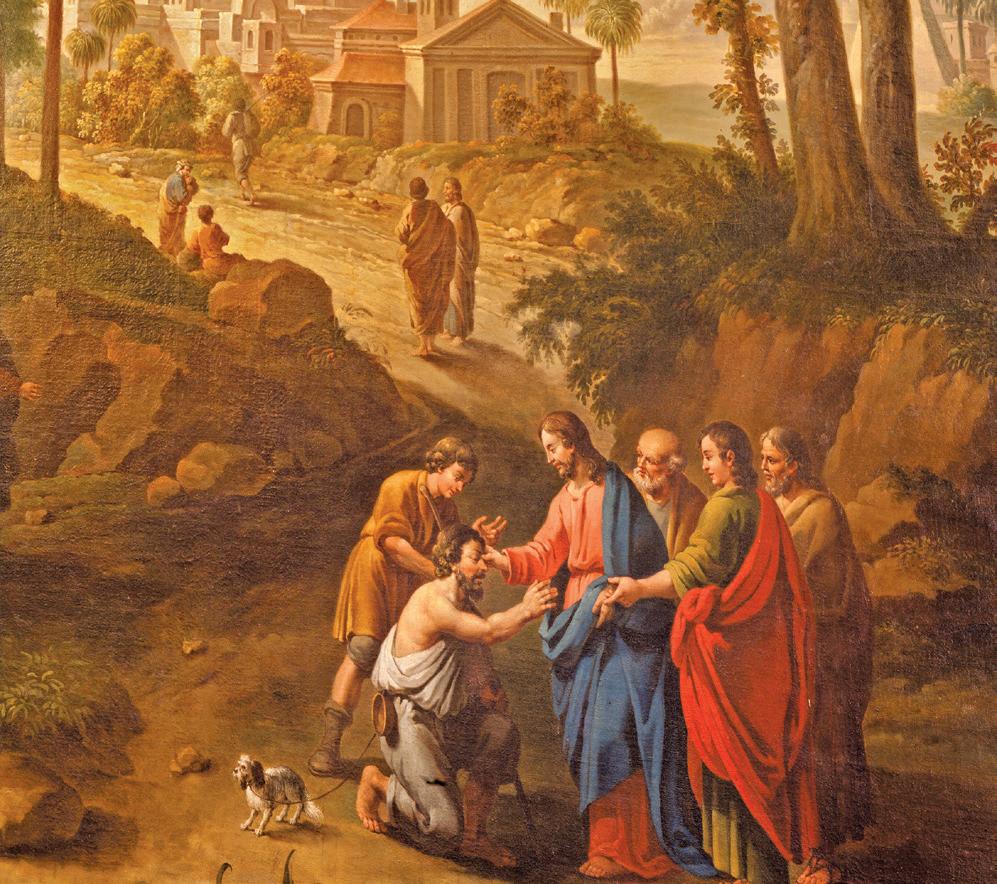
Copyright © J. S. Paluch Co. C
MONDAY 2 SM 7:4-5A,
THE HUSBAND OF MARY, the mother of Jesus, and the legal father of Jesus according to Jewish law, Joseph is a model of humility and obedience to God's will. He followed God's instructions, given by angels in dreams, and took the pregnant Mary into his home as his wife, protected her and Jesus from the child's birth in Bethlehem through the family's sojourn in Egypt, and provided for them as a carpenter in Nazareth. This feast, which was celebrated locally as early as the ninth century, became a universal feast in the 16th century. Pope Pius IX named Joseph patron of the universal church in 1870; he is also the patron saint of carpenters, the dying and workers.
“
What signs of life and hope can we see, to help us move forward and try to make our world a better place?”
— Pope Francis
When the swallows come back to Capistrano, that's the day you promised to come back to me. When you whispered, “Farewell,” in Capistrano, 'twas the day the swallows flew out to sea … When the swallows come back to Capistrano, that's the day I pray that you'll come back to me.
“WHEN THE Swallows Come Back to Capistrano,” is the song forever linked with St. Joseph’s Day and the Return of the Swallows Celebration at Mission San Juan Capistrano.
Mechelle Lawrence Adams, the Mission’s executive director since 2003, endearingly says that of the 21 missions situated along California’s Mission Trail, Mission San Juan Capistrano is the only one with its own theme song.
The song is also, in large part, responsible for the Mission’s revival and popularity as a tourist destination, according to Lawrence Adams.
“People put it on their bucket lists,” the director said. “They want to go to the Mission and go see those birds. The Mission starts to rise in another life as a destination.
What they are talking about is that something old, something beautiful, something romantic and that song captures all of that.”
Since singer/songwriter Leon René, wrote “When the Swallows Come Back to Capistrano” in 1939, the song has been recorded in a variety of styles by such artists as the Ink Spots, Glen Miller and his Orchestra, Gene Autry, the Dominos, Pat Boone and even Elvis Presley.
The song was parodied in a 1949 Looney Tunes cartoon titled “Swallow the Leader,” and lampooned in an episode of “The Simpsons” where a talking head on a TV newscast proclaimed, “It’s the time of year when the swallows return to
Springfield.”
The song is also performed during the annual Romance of the Mission Gala held in September, when the singer is asked to perform their own version of song, Lawrence Adams said.
“So, over the last 18 galas, the song has been performed in Dixie style, southern soul style and as a duet,” she said. “It has been done operatic, in just all kinds of cool ways.”
But when the song is performed during the annual Return of the Swallows and St. Joseph’s Day celebration every March 19, it is always performed to an accompanying mariachi band.
Catholic Singer Renée Bondi is responsible for that.
Bondi, a lifelong resident of San Juan Capistrano and founder of Bondi Ministries, will perform the song during the annual celebration for the 20th consecutive year on March 19.
For decades, Leon René himself sang the song for the St. Joseph’s Day festivities
René then passed the torch to his son Rafael who went on to perform the song for years.
Bondi recalled wonderful memories from her childhood attending Mission Basilica Catholic School, when the students donned Spanish costumes and danced for the audience every St. Joseph’s Day.
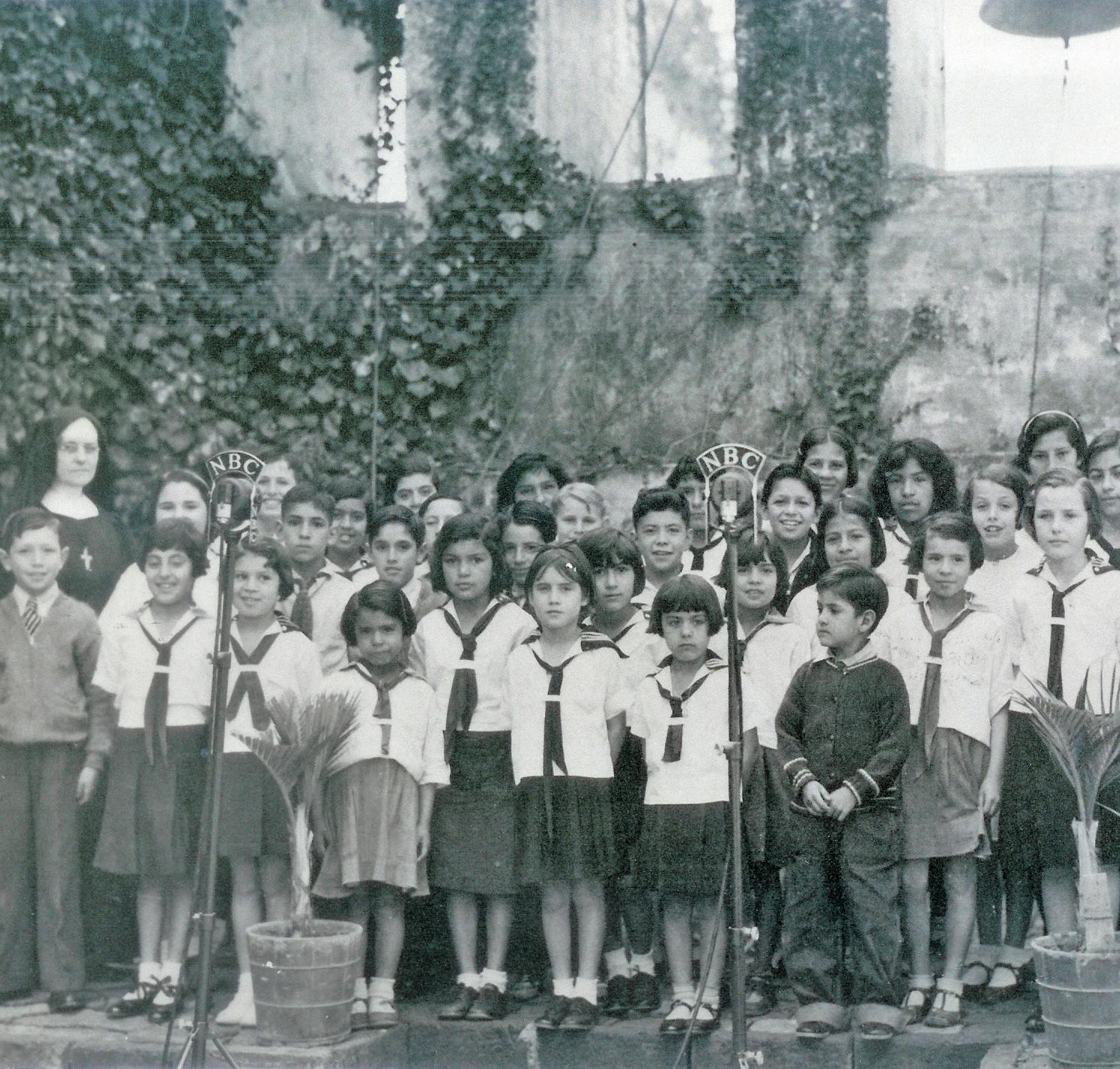
“The highlight was watching Leon René step onto the stage with mariachis and singing “When the Swallows Come Back to Capistrano,” the romantic ballad he composed in 1939,” said Bondi, who went on to study music education and became the parish music director and school music teacher and then the choir director at San Clemente High School.
Bondi’s story is itself inspiring.
At age 29, Bondi shattered her spine in a bizarre accident in her home, losing the use of her hands and legs.
She could barely speak above a whis-
per and lost her singing voice.
Bondi persevered and her voice was restored, a miracle she credits to God.
But there may never have been an annual St. Joseph’s Day celebration at the Mission or a song about the swallow return if not for the accomplishments of Fr. St. John O’Sullivan, who was put in charge of the Mission in 1910.
By then, the Mission was nearly in ruins and Fr. O’Sullivan undertook the much-needed restoration of the sacred space.
In his book, “Capistrano Nights,” Fr. O’Sullivan explained how the swallows came to find sanctuary at the Mission.
While walking through town one day, Fr. O’Sullivan noticed a shopkeeper
wielding a broomstick, batting down the mud swallow nests that were under the eaves of his shop.
When the pastor asked the shopkeeper why he was destroying the swallows’ nests, the man said the birds were a nuisance and dirtied up his property.
Concerned for their wellbeing, Fr. O’Sullivan said, “Come on swallows, I’ll give you shelter. Come to the Mission. There’s room enough there for all.”
So, the swallows’ annual migration to Argentina every October and return to the Mission every year on March 19, became an annual celebration.
Fast forward to March 19, 1939, when René was sitting at the table of his Los
Angeles home waiting for his wife to finish cooking breakfast.
With his wife seemingly in no big hurry to finish preparing his morning meal, René began listening to a radio broadcast of the annual Return of the Swallows celebration at Mission San Juan Capistrano.
Then, he said it:
“By the time the swallows come back to Capistrano, maybe I’ll get my breakfast,” René quipped to his wife.
No sooner was the comment uttered, when René was struck by a bolt of inspiration.
“It dawned on me that this was a great title for a song,” René said years later for recording he made for Bill Ortega, owner of the Ortega Capistrano Trading Post.
“So quickly I went to my studio and sat down to the old upright and in a short time I completed half of the song,” René said.
“I ran back into the house all excited and said to my wife, ‘Listen to this!’” René said. “I sang a few bars of the song, and she said, ‘Oh that’s beautiful!’ She had completely forgotten she was angry with me and cooked a wonderful breakfast — ham, eggs, French toast, the whole works!”
In the years between the final year Leon René's performance of the song for St. Joseph’s Day and the first year Bondi sang the song in 2004, the song was performed by several artists with recorded piano music as accompaniment, losing much of its luster.
“I have to admit, the musical snob in me said, ‘This song deserves better and is best performed with mariachi, how it was originally written and recorded,’” Bondi said.
When Lawrence Adams became executive director of the Mission in 2003, she was looking for a local inspirational singer.
“We were looking for somebody to step into those shoes and bring
HOW MUCH DOES A “yes” cost? Well, let’s see. You answer the phone to hear your neighbor saying, “I’m sorry to bother you at the last minute, but I just saw I have a flat tire and my child’s dentist appointment is in 20 minutes. Would you be able to drop us off?”
As you pause to think about it, you see your plans for having a cup of coffee and checking your email float away, while a small voice within whispers, “It is Lent, after all” and so you say “yes.” Cost: A half hour of your free time.
How about this next scenario? Your friend asks if you would be able to use your truck to help him move his daughter to college in two weeks, acknowledging that it would take the entire day. You hesitate, but then, remembering how many times he has helped you, you say “yes.” Cost: An entire Saturday.
This third scenario involves a much higher price. Suppose someone you deeply love asks you for a major commitment, one which could alter the shape of your future, and you say “yes.” Cost: An entire lifetime.
There was a young couple many years ago who were engaged to be married when suddenly all their plans were turned upside down. He saw the necessity of breaking off the engagement for a very serious reason, although he deeply loved his bride-to-be. She saw that what she was being asked would totally change her future, and perhaps even cost her life.
Joseph was a carpenter from the town of Nazareth, and Mary a teenage girl betrothed to Joseph, when suddenly she received a visit from the Angel Gabriel.
God sent this messenger to ask if Mary was willing to be the mother of his son, Jesus. Thankfully for each of us, she said “yes.”
In Israel 2,000 years ago, to be pregnant out of wedlock was considered a serious sin, and the woman could be stoned to death. We read in the Gospel of Matthew that “Joseph her husband, since he was a righteous man, yet unwilling to expose her to shame, decided to divorce her quietly.” (Mt. 1:19) What a heartbreaking end to their joyful plans!
What do we do when things don’t go as we hoped, when our plans go awry, when our dreams can’t be fulfilled? It depends on how serious it is. If simple, we might shrug it off, get frustrated or disappointed. If major, such as the loss of a job or even worse, the loss of a loved one, our response will be more serious. Some of us may feel so let down and abandoned by God that we turn away completely. Others might try to keep going, perhaps
with a few prayers but mainly using our own strength and determination. And still others may allow this to strengthen our relationship with God, as we surrender the situation to God and trust in God’s merciful love to see us through and provide us with all we need. This is what Mary and Joseph did.

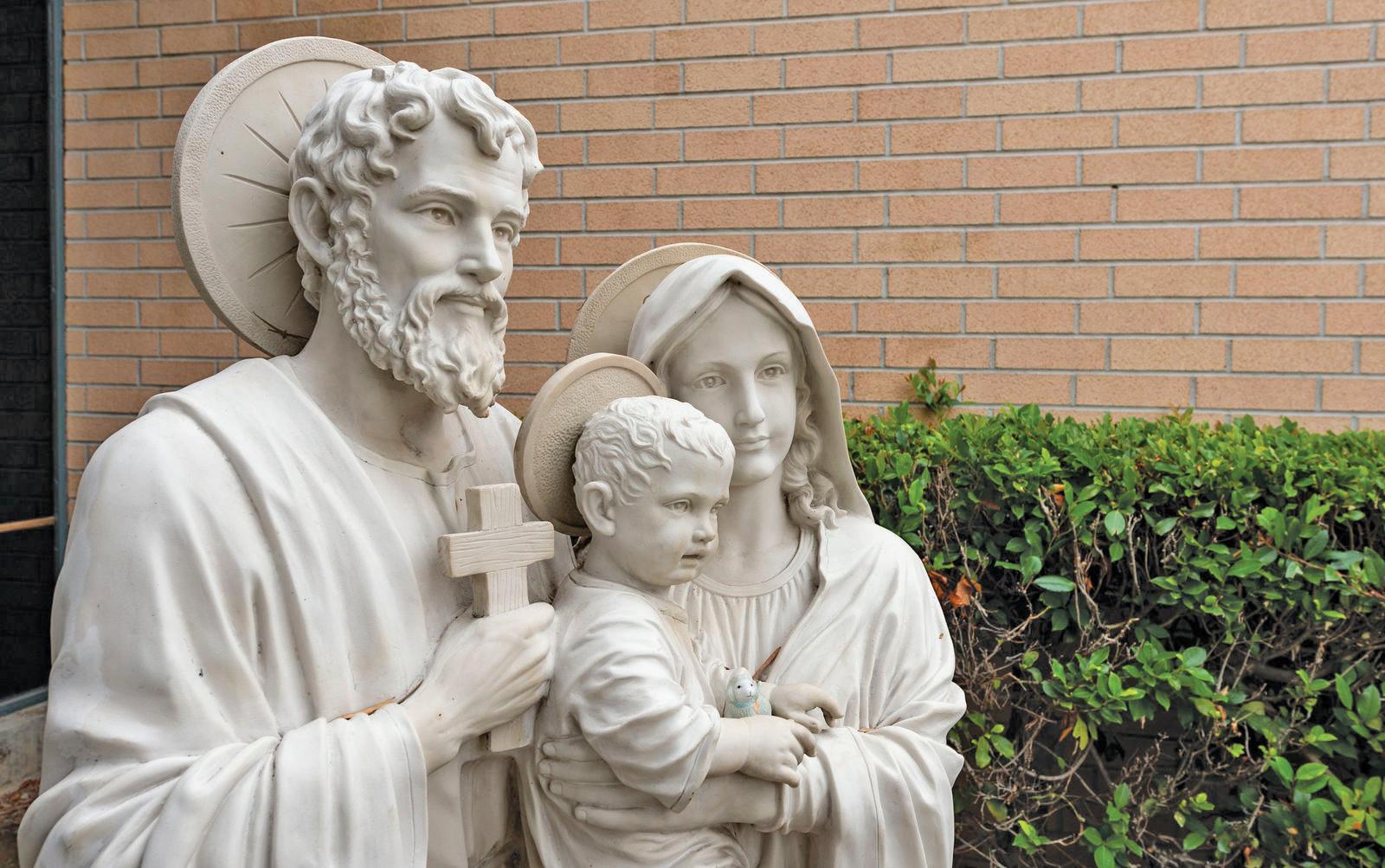
Joseph, after being reassured by an angel in a dream that Mary had not been unfaithful to him and that “…it is through the Holy Spirit that this child has been conceived in her” (Mt. 1:20) brought Mary into his home, and they lived a chaste life together, loving and supporting each other and raising their son Jesus, He who is truly human and truly divine.
This week we celebrate their feast days. Today, March 19, is the feast of Saint Joseph, husband of Mary, and Saturday, March 25, is the feast of the Annunciation. What price are we willing to pay, to say “Yes” to God’s good plan for our lives? Is it a little “Yes” here and there, or a lifetime “Yes?”
Let’s daily ask their intercession to say and live a lifetime “Yes.” C
FOR MANY, THE repetition of reentering the same spaces can become a monotonous chore. Not for C.J. Levin. Whenever the Mission San Juan Capistrano docent visits the historic grounds, it’s special. And she’s been doing it for decades.
“Every time I come in, I just feel better,” Levin said on a recent weekend at the Mission. Its VIP tour program was recently relaunched and is a wonderful offering that should be on anyone’s to-do list who loves local history and beautiful architecture.
The roughly 90-minute VIP tours are offered on Saturdays at 10 a.m. and Sundays at 2 p.m. through reservations at www.missionsjc.com/onsite-tours. Each guest receives a special memento.
“We are thrilled to bring back weekend guided tours after the program was curtailed by the impacts of the pandemic,” said Mission San Juan Capistrano Executive Director Mechelle Lawrence Adams. “We hope that guests will enjoy seeing the Mission up-close and more personally through this program, leaving with an even better perspective of the importance of this place.”
Tours are limited to groups of 25. The cost is $35 for adults and $30 for children.
The basic story of Mission San Juan Capistrano — dubbed the “Jewel of the Missions” — is well known to many. It was founded in 1776 by Spanish Catholics of the Franciscan Order. After falling into disrepair and changing ownership in the decades later, by the 20th century the Mis-
sion received considerable TLC to become the jewel it is today.
Moreover, though it’s not the oldest of California’s 21 missions (that distinction belongs to Mission San Diego de Alcalá in 1769), Mission San Juan Capistrano is undoubtedly the most famous. That’s thanks to the legend of the swallows migrating there on St. Joseph’s Day — a story immortalized in pop culture, from the Ink Spots’ 1940 song to “Looney Tunes” antics.
That said, though many will know that basic history, VIP tours from guides like Levin will elevate appreciation for the historic site.
On the weekend of one recent tour, the sun was shining. The Mission was in
its usual splendor. The bells tolled from Mission Basilica, a thriving parish led by its pastor, Monsignor J. Michael McKiernan, that also boasts of a school. Scents wafted in from Heritage Barbecue across the street. It was a great day to stroll the grounds.
Levin introduced herself and learned that her tour — her fourth since the VIP program was resurrected — had coast-tocoast participants coming from Florida to Northern California.
The excursion began with a basic overview of mission history, noting the considerable shift in Spanish mentality from taking America’s resources to instead colonizing and evangelizing the native population. Levin also pointed out the

parallels of California history and the American colonies: Each coast was being taken over by European settlers around the same period.
Interestingly, that European history was far predated by the history of the Acjachemen, the indigenous people of the area whom the Spanish renamed Juaneños. Near the main entrance, Levin pointed out some grinding stones the hunter-gatherer Acjachemen used, presumably for thousands of years.
Moments like that, from a well-guided VIP tour, help bring the history and heritage of Mission San Juan Capistrano alive.
Levin offered guests further factoids,
CONTINUED FROM PAGE 8
like the 5,000 adobe bricks needed to construct a small room, or that fences didn’t surround the Mission until the early 20th century. There are even some cool firsts: California’s first chimney and vineyard, and its oldest existing metalworking structure.

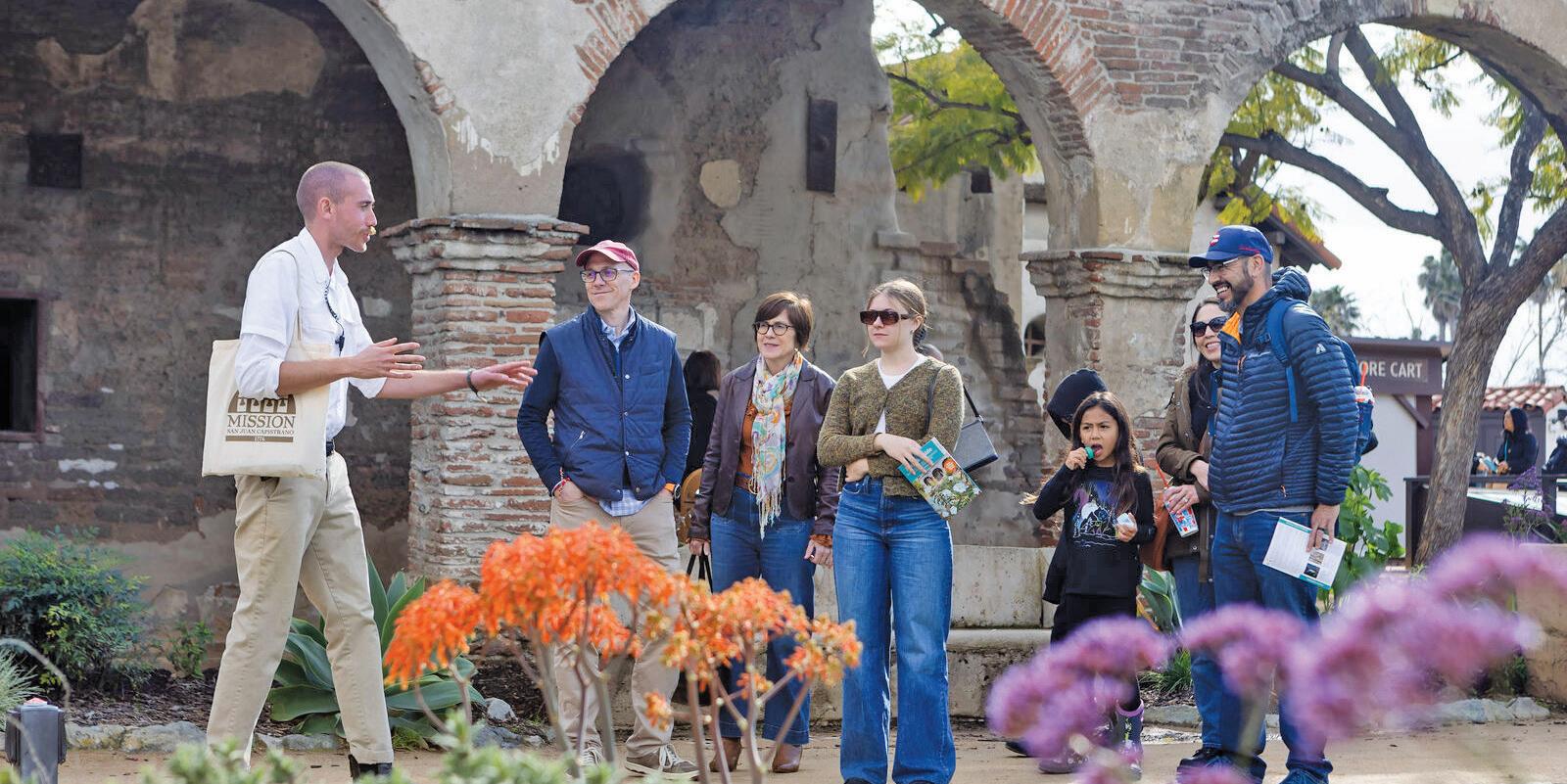
In 1988, the American Society for Metals (now called ASM International) recognized the metalworking structure with a special historical plaque. Interestingly, the whole setup was lost to the elements for many years because it got covered up by sediment. It was rediscovered in the 1930s, Levin said.
“Many things happen by accident,” she added with a smile, soon admiring the greenery that contrasts that metalworking history. “We’re so proud of our gardens here.”
Later in the tour, the group learned about the imperfect dimensions of the buildings themselves — that was caused by imprecise tools and varied measuring styles — and the Mission’s connection to President Abraham Lincoln.
It concluded with a visit to the always-inspiring Serra Chapel — the site of another California-first factoid being the state’s oldest continually operated chapel — and the Ruins of the Great Stone Church.
The Serra Chapel alone has enough intricate, painstakingly crafted details to merit hours admiring it all, even though it’s a small space. The chapel has been expanded and restored over the decades, Levin explained.
“That’s what we are always trying to do here,” she concluded. “Preserve, conserve, dedicate.” C
CONTINUED FROM PAGE 7
that back,” Lawrence Adams said. “Renée Bondi was a natural choice.”
Now a singer/songwriter and inspirational speaker, Bondi recorded When the Swallows Come Back to Capistrano with the band, Mariachi Espuelas de Mexico in 2005.
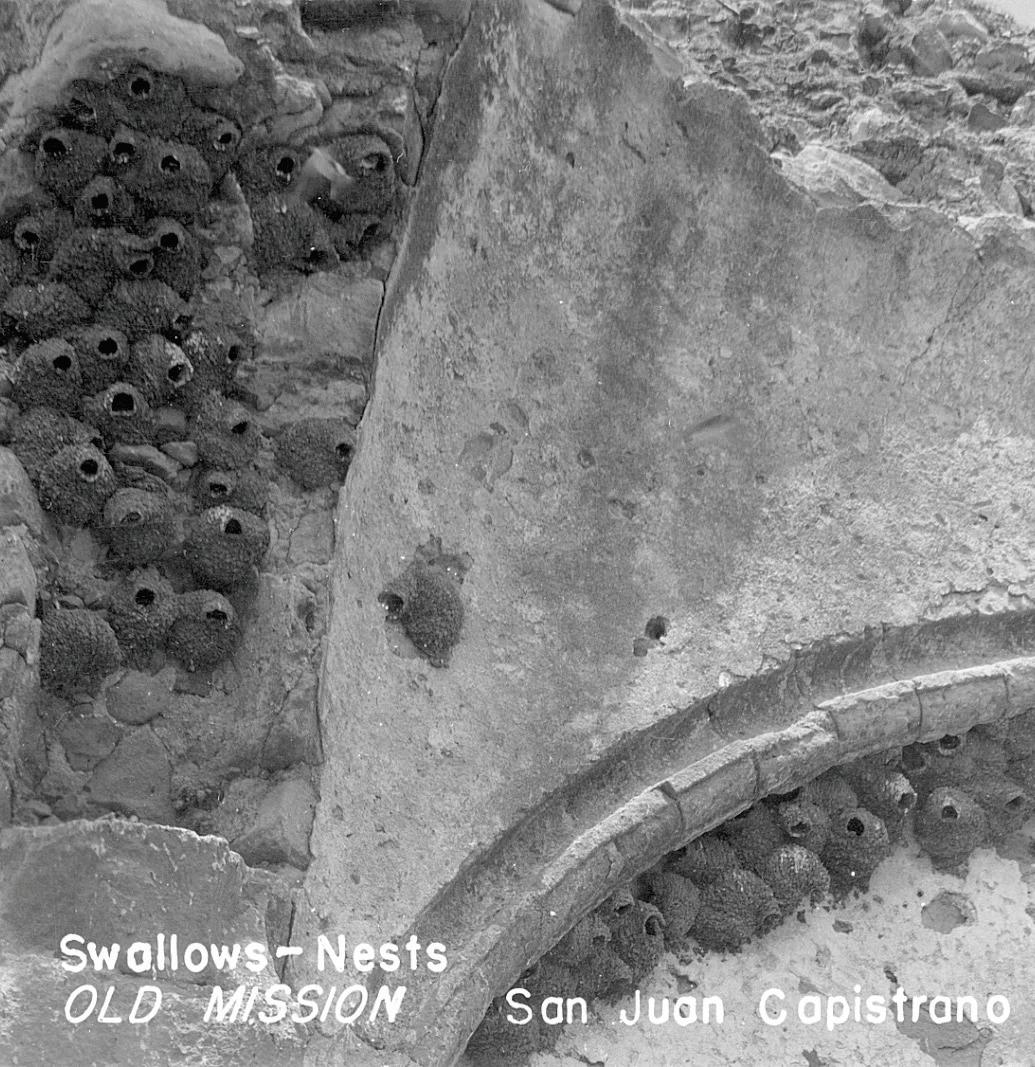
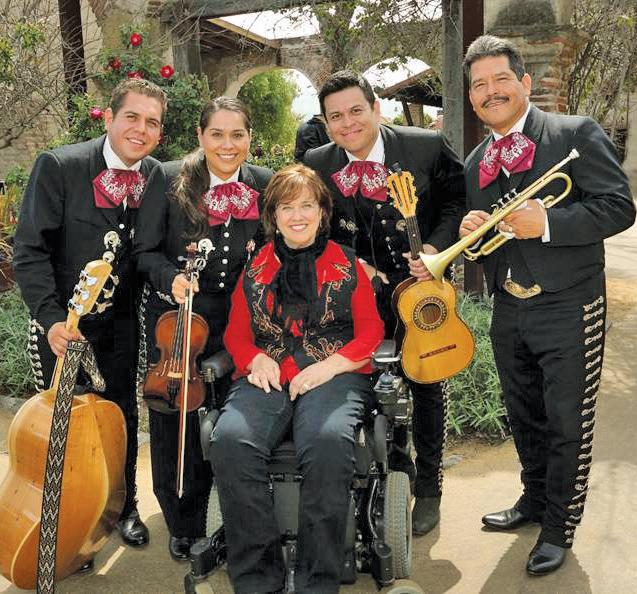
“It is still the arrangement used today, 84 years after Leon René first composed and recorded it,” Bondi said.


For Lawrence Adams, the song, like the Mission itself, represents a homecoming.
“Homecoming can mean a lot

MECHELLE LAWRENCE Adams is the embodiment of stewardship. In her 20-year role as executive director of Mission San Juan Capistrano, she has been dedicated to preserving the “jewel of the missions” — and inviting visitors of all ages, backgrounds and faiths to witness its beauty.

And after two decades, from where does she continue to draw inspiration?
Well, from the very grounds she first walked at the age of 10 during her first visit there, and the same grounds she now walks every day for her job. The very grounds where a saint once walked centuries ago.
St. Junipero Serra, a Franciscan missionary born in Spain, founded nine of California’s 21 missions, with Mission San Juan Capistrano being founded on Nov. 1, 1776.
And while the grounds were founded by a saint, they were built by Indigenous, baptized Catholics - the Acjachemen people.
“We look at their contributions as builders of the Mission with a sense of gratitude,” she said. "We strive to instill respect in everything we do for the original builders while also celebrating Serra’s founding of the Mission San Juan Capistrano."
The heart of Mission San Juan Capistrano continues to be Serra Chapel, the only chapel still standing where St. Serra celebrated Mass.
Lawrence Adams said the Mission has records of the sacraments being celebrated there by St. Serra’s signature in the sacramental registries.
“It is the most historically significant
chapel in California,” said Lawrence Adams, who works on behalf of the Mission Preservation Foundation.
Over the past 20 years, over $2 million has been invested into the care and stewardship of Serra Chapel.
“Serra Chapel reflects a lot of things — early California history, the ongoing celebration of the sacraments and the containments within the architectural setting itself being historically significant,”
Lawrence Adams likens the life of Serra Chapel to the life of a human being. And just as we all do, the chapel has gone through many transformations.
It began with a birth – the Mission’s founding by St. Serra. After withstanding natural disasters, it started to age and
during the secularization of the missions in the 1830s, came under private ownership before being returned to the Catholic Church by President Abraham Lincoln in 1865.
During the time it was privately owned, the family living there used Serra Chapel to store hay for their horses. Since the hay needed to stay dry, the family kept the roof intact.
“If they hadn’t kept the roof intact,” said Lawrence Adams, “it probably would have been lost to time and to erosion.”
The chapel was in the period of decay when Fr. John O’Sullivan came upon the scene in 1910, and he aimed to bring chapel back into use.
He started charging an admission fee to raise money for its care, thus beginning a 20th century era of preservation.
Many of the artifacts that are housed within the chapel today come from different eras because different improvements have happened over time.
For instance, the golden retablo altar piece is not original to the chapel. It was acquired in the early 1920s by Fr. O’Sullivan.

But due to its height, the retablo didn’t fit inside the chapel.
So, Fr. O’Sullivan expanded the area behind the sacristy to fit the retablo. Today, the bottom of the steps before the altar is where the chapel once ended.
Fr. O’Sullivan also started the annual swallow celebration at the Mission and with Leon René’s composition if the song, “When the Swallows Return to Capistrano” in 1939, the Mission found itself to be a tourist destination.
St. Serra could not have envisioned that the Mission would one day belong to the world.
When Lawrence Adams arrived in her position in 2003, she said it was very clear
Across America's (WAA) Mobile Education Exhibit's colorful 48-foot-long trailer rolled into the parking lot of Our Lady Queen of Angels (OLQA) Catholic Church in Newport Beach on Feb. 27.
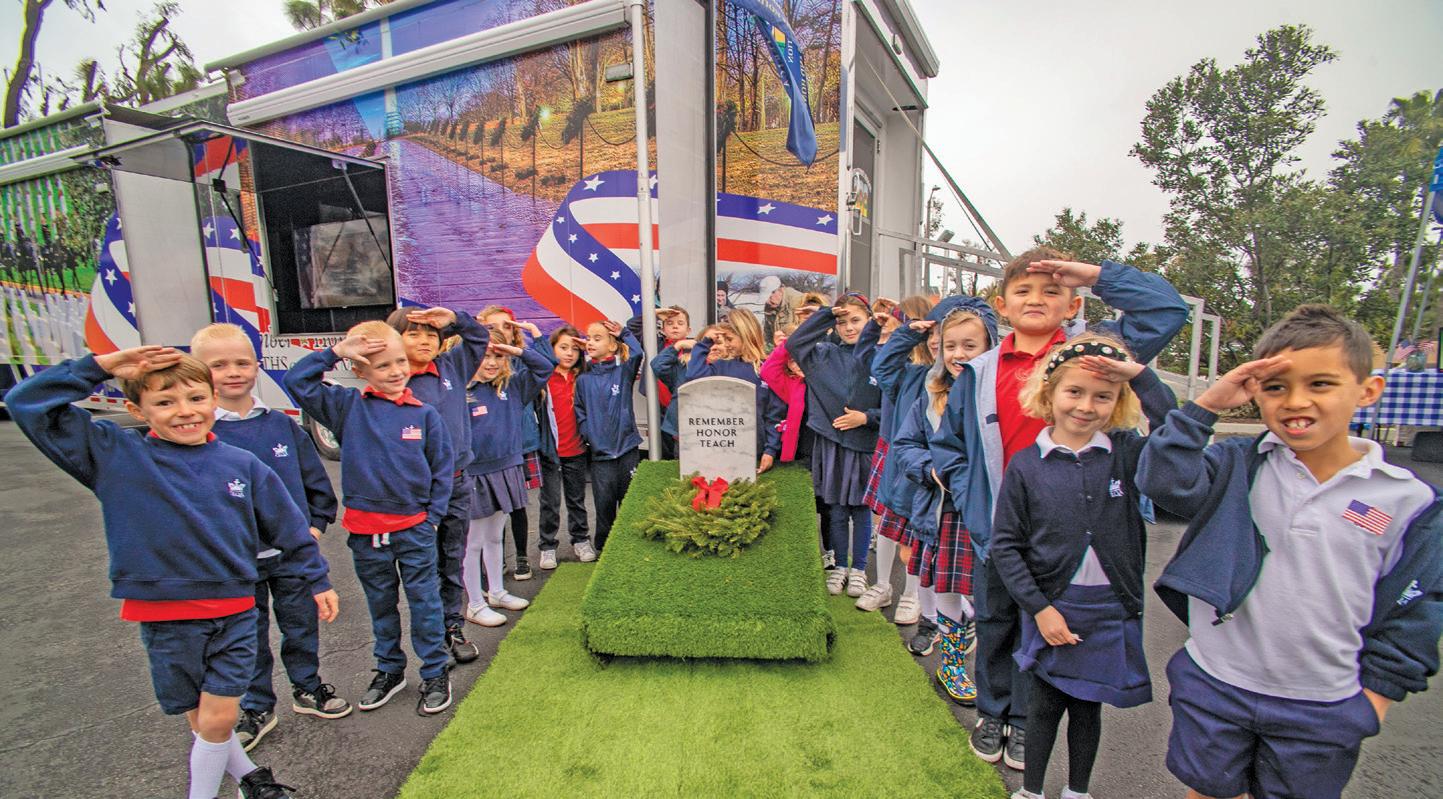
Co-hosted by the Colonel William Cabell Chapter of the Daughters of the American Revolution (DAR), the parish and school, the exhibit gave students a chance to understand and appreciate the sacrifices of fallen American veterans.
“The mission of Wreaths Across America is to remember the fallen, honor those who have served and their families and teach the next generation the value of freedom,” explained Karen Worcester, WAA executive director.
The organization is dedicated to placing wreaths on the graves of veterans in cemeteries worldwide.
The exhibit is a unique museum on wheels that teaches students and the community about the importance of freedom by using a trailer full of interactive exhibits, short films and veterans' shared stories, including a video of a Gold Star mother remembering her heroic son. A small theater has space for an audience of 20.
Our Lady Queen of Angels students were shown an exhibit of how WAA has grown since it was founded in1992 by Maine businessman Morrill Worcester, who wanted to expand the annual wreath-laying ceremony at Arlington National Cemetery.
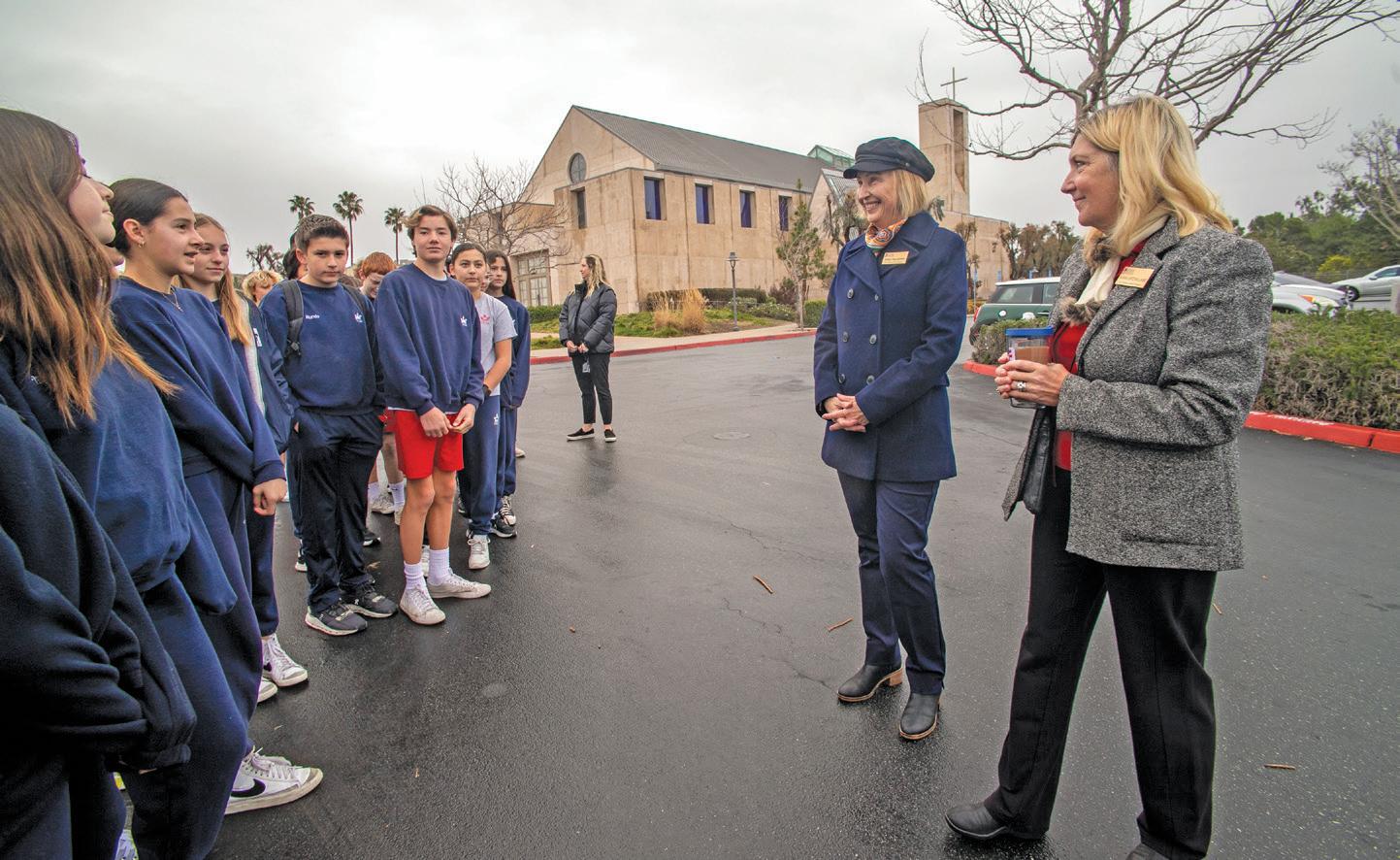
From a modest 5,000 wreaths in 1992, WAA expanded to 33,000 wreaths in 236 locations in 2007, and then to 2,700,000 in 3,700 locations in 2022.
Aerial views of veteran cemeteries in Europe were part of the program along with scenes of the wreaths being placed on the memorials.
Newport Beach was the WAA truck’s
only stop in Orange County. Upon learning that the exhibit would be traveling through California as part of its national tour, DAR Chapter Service for Veterans Chair Anne Pellegrini contacted Our Lady Queen of Angels Church and School about co-hosting the exhibit in the church parking lot. Both Fr. Steve Sallot,
pastor, and Principal Dr. Julie Tipton were enthusiastic about the opportunity to honor veterans.
“My husband is a 30-year Marine Corps veteran,” explained Tipton. “Our kids study American and world history, but as part of our Catholic teaching, we are called to serve others. Our students
will be introduced to the service of our country. We want them to understand that they can contribute to the greater world. By bringing exhibits such as WAA to our school, our students have the opportunity to develop a greater appreciation of veterans, a deeper understanding of their sacrifices and a sense of pride and patriotism.”
Fr. Steve Sallot, pastor of OLQA, said his father was a Navy pilot in WWII and several of his uncles served in that war as well. Some of his cousins and friends fought in Vietnam and growing up in Tustin, he lived close to two military bases of LTA and El Toro.
“We are aware that many times veterans and their families do not get the recognition and assistance that our country owes them,” said Fr. Sallot.
Pellegrini grew up in a military family and Fr. Sallot said he appreciated her desire to bring recognition to veterans and honor those deceased veterans.
“Our parish staff and especially our parish school staff supported the plan,” he said.
Despite the threat of rain and cold, windy weather, a good number of parishioners and community members also toured the exhibit.
“Our nearly 400 parish school students experienced the displays and I believe came out with a more profound appreciation of those who have served and those who gave their lives in service to the country we are so blessed to be living,” said Fr. Sallot.
After leaving Orange County, the WAA Mobile Education Exhibit will stop in Carlsbad, San Diego and El Centro before heading for Arizona. A number of other stops are sponsored by local chapters of the DAR.
Wreaths for veterans may be sponsored at wreathsacrossamerica.org/CA0166P. Wreaths will be placed on National Wreaths Across America Day, on Dec. 16, 2023. C

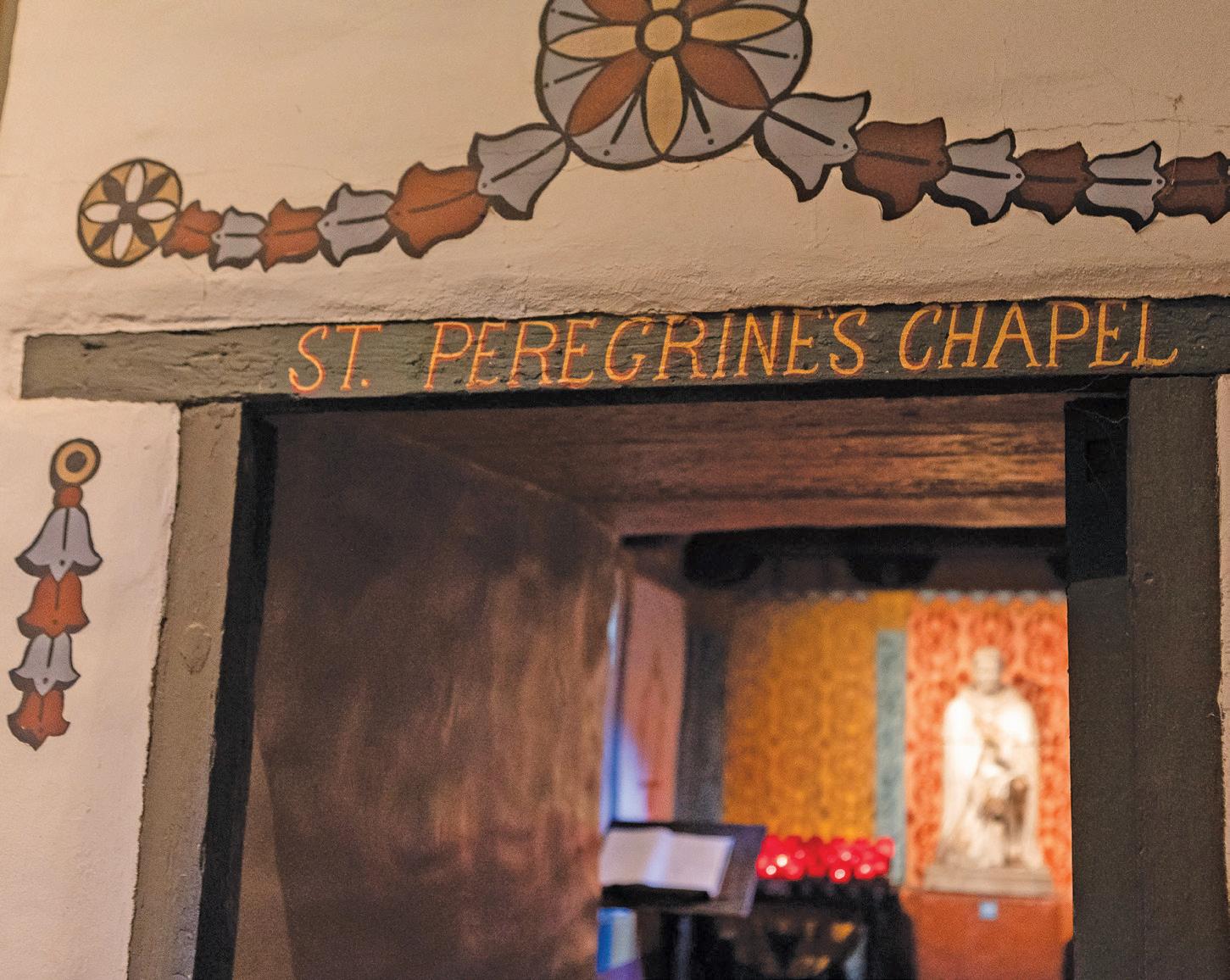

to her that there was not an understanding of what needed to be done to polish this gem and who its audience was.
“You have the faith-filled Catholic, you have the non-denominational Christian, you have the Jewish person who comes in because they love history and culture, you have the students who are coming to learn about California curriculum and you have the cancer sufferers looking for hope,” said Lawrence Adams.

In the 21st century, it has been about the preservation and stewardship of Serra Chapel, and for these last 20 years, its executive director has been emphasizing the importance of having many ambassadors.
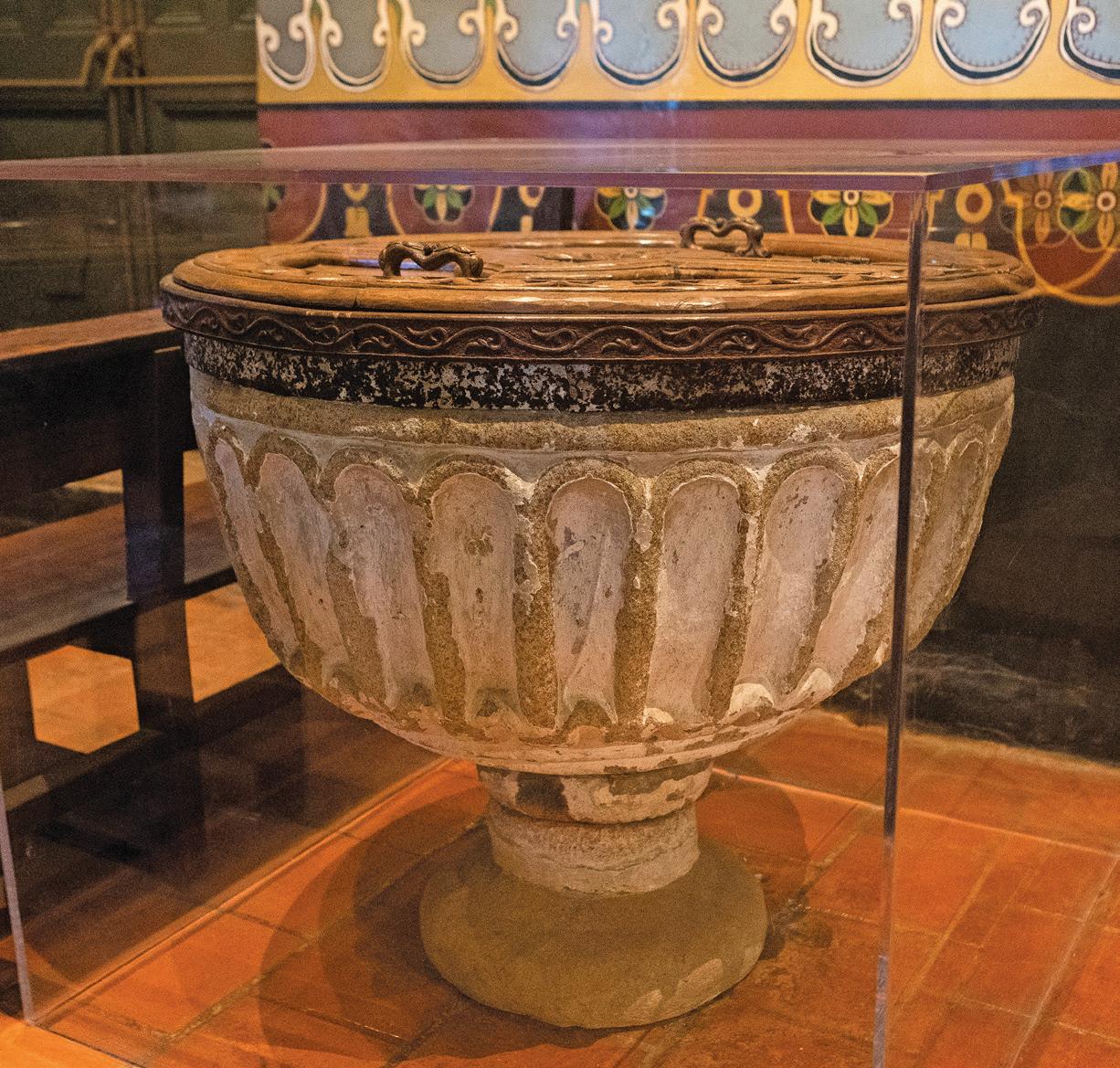
And as it is, Serra Chapel always needs attention. From the walls to the floors to the artwork – conservation is ongoing.
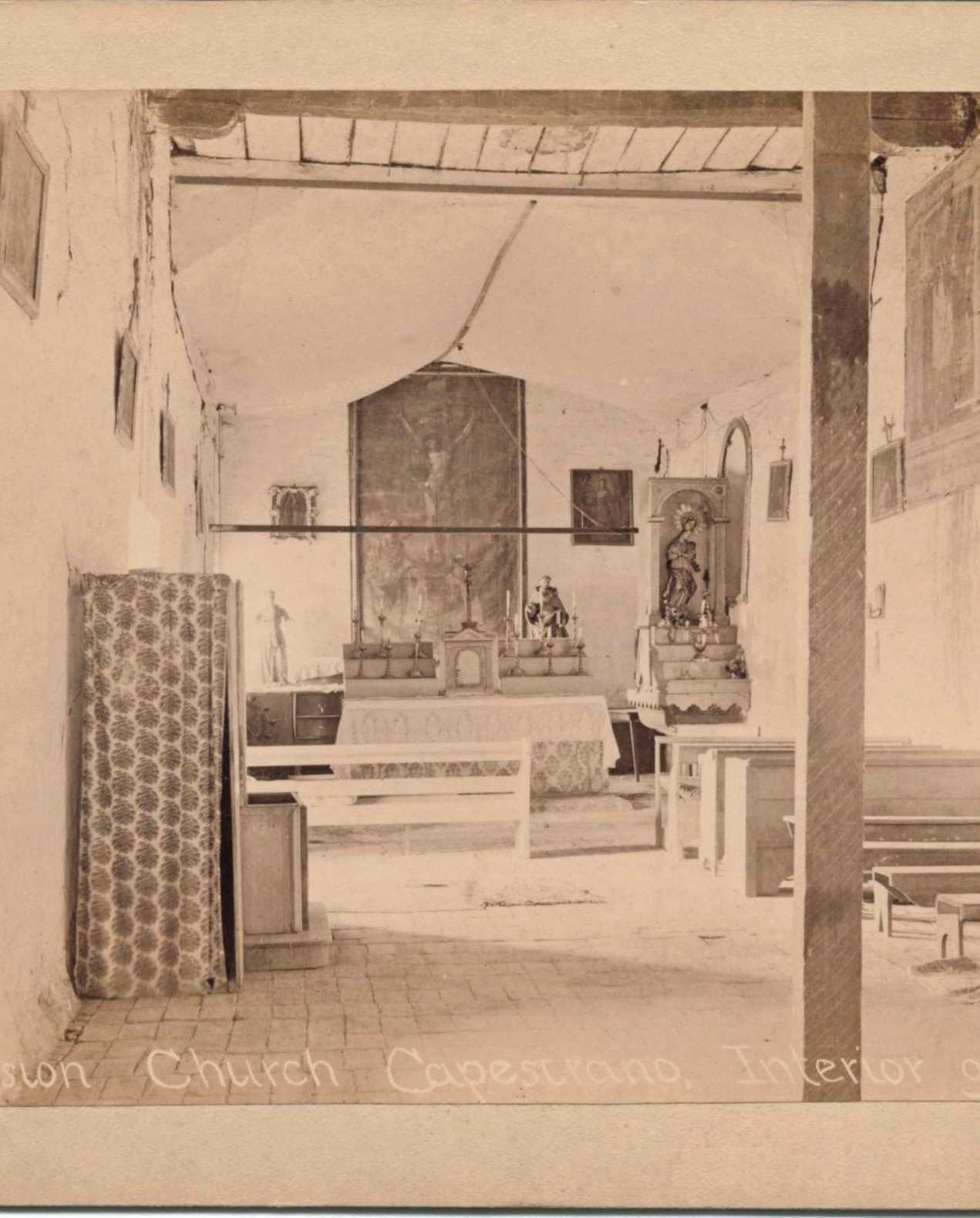
And strict guidelines are in place.
“Nothing gets moved without me knowing about it,” said Lawrence Adams. “Nothing goes out for conservation without oversight. Everything is numbered and in a database. Everything is insured. Everything is evaluated on an annual basis.”
It’s never been about “rebuilding or adding new things” according to Lawrence Adams. It has always been bringing the chapel back to its past glory.
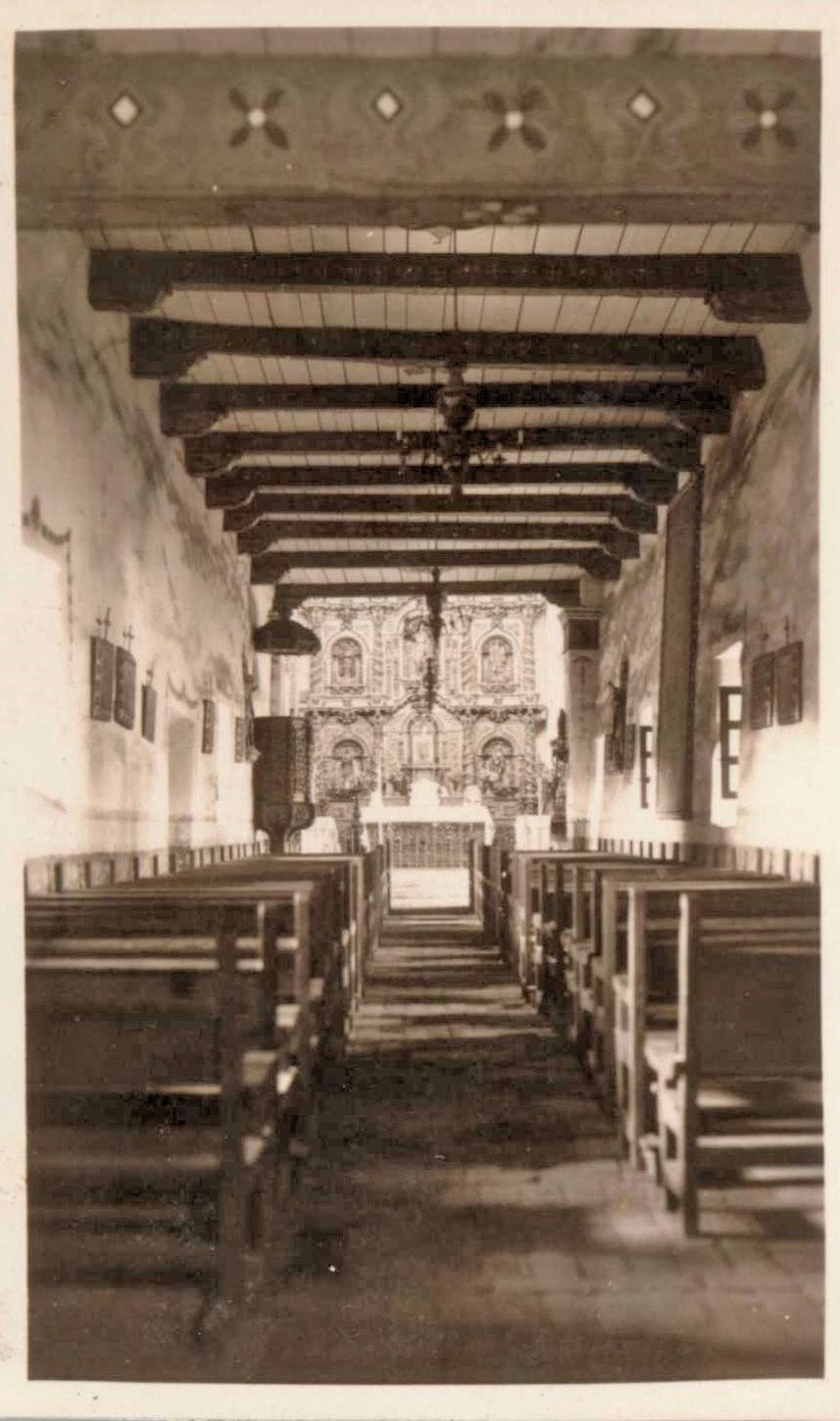
“I’ve been here 20 years and guess what?” she asked. “We are starting to do projects twice. It’s time to go back to lighting because LED has emerged as a better environmentally cost-effective option.”
Visitors are diverse, multicultural and most welcome. There’s a five-language audio tour to prove it.
But for Orange County Catholics, Serra Chapel is where it all began. Lawrence Adams calls it the “mother house” and a place she thinks all Catholics should visit and pay homage to.
“When’s the last time they came in here and reflected on their faith journey?”
To make a donation to future preservation projects, visit www.missionsjc. com/donate C
